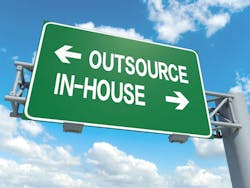My perception is that most politicians and people outside of industry typically associate the loss of U.S. manufacturing jobs with blue-collar-employee factory jobs. Boeing’s 737 Max Software Outsourced to $9-an-Hour Engineers (June 28) presented another perspective by describing Boeing’s strategy of replacing its white-collar employees with supplier personnel from low-wage countries. I use the term low-wage rather than what some people refer to as low-cost since, as the article describes, this outsourcing of U.S. jobs usually leads to all sort of costs for companies that adopt this strategy. And while Boeing has been used as an example here, this is a strategy that has been implemented by many, many U.S.-based original equipment manufacturers (OEMs)
What are these hidden costs? In the factory, for instance, OEMs need to apply additional resources—either onsite or in receiving inspection—to verify the quality of product coming from foreign sources and hold extra purchased material inventory to guard against production line stoppages. They also lose incremental sales when their product forecasts are below actual demand, since foreign suppliers are not likely positioned to respond quickly enough to maintain their customers’ fill rates, an important executive level metric at most large corporations.
In the office, white-collar job losses occur when the work of professional employees is resourced to low-wage foreign suppliers. Again, while the pay to such workers is much lower than pay to domestic workers, there are all sort of additional costs that the OEM in question will likely need to absorb. For instance, communication and collaboration is usually inefficient—due to language, culture and a lack of understanding of product function; i.e., they just work to a spec. And anyone who has worked in industry will tell you that it is almost impossible “up front” to specify requirements down to the level required for a person with no product familiarity to deliver effective output, which domestic professional employees generally do, above-and-beyond a specification. This negatively impacts both the quality of the output and the time it takes time to deliver it. There is a reason that people say time is money, since delays, especially in product development and production start-up, can cost “big bucks.”
Unfortunately, for most of the last three decades, OEMs have either disregarded these additional costs—focusing primarily on lower wages and piece-price—or severely underestimated and quantified them. Hopefully, the current turbulence in trade will nudge corporations to take another look at this issue and put together a more complete business evaluation between the domestic vs. foreign sourcing strategy, especially in light of the dynamics of the markets their products compete in.
Huh?
A couple of weeks ago I praised Apple for having a “Plan B” for the iPads it currently sources from Chinese-sited contractors. Now, Apple Will Move Production of Mac Pro to China Amid Trade War (June 25) has me scratching my head about the seemingly inconsistent approach to that company’s overall sourcing strategy. The Mac Pro has been Apple’s only product manufactured in the U.S., so once the Shanghai factory is operating, none of their products will be produced in their biggest overall market. And in addition to this assembly operation, many of the parts and components used in its manufacture are also sourced in China.
Apple spent decades building one of the largest supply chains in the world, a high percentage of its sources being in China. That makes it one of the most exposed companies to U.S. tariffs on Chinese manufactured products. Apple’s CEO, Tim Cook, had recently urged the Trump administration not to proceed with another round of tariffs, saying it would reduce the company’s overall contribution to the U.S. economy.
I’d like to challenge Mr. Cook to explain to the employees currently assembling the Mac Pro in Austin, Texas, how he can talk about tariffs negatively impacting the economy when the biggest quantifiable negative impact will be their laid-off employees.
This is certainly one case where the 2017 tax reduction given to large corporations isn’t paying off for workers.
Buy Chinese?
A blurb in China’s Biggest Startups Ditch IBM and Oracle for Home-Made Tech (June 25) caught my attention. For years, companies like Oracle and IBM have invested heavily in building new markets in China for their industry-leading database management systems. The timing of the Chinese move away from those two American companies is likely in response to U.S. actions regarding its own tech giant Huawei—actions which, in the eyes of many countries around the world, are justified.
The “blurb” in question, however, is that many of IBM and Oracle’s current Chinese customers “are migrating away from Oracle and IBM’s services toward PingCAP’s (China’s primary database developer), encapsulating a nation’s resurgent desire to Buy Chinese.”
I’d be surprised if Chinese database management companies have developed expertise to the point where they are positioned to challenge IBM and Oracle as world leaders in that industry. So it appears that those Chinese companies in question are willing to source with a second-tier supplier solely due to it being located in their own country. I wonder where the direction for this move—remember, China is a communist state—is coming from for this. China 2025?
Paul Ericksen's columns are part of IndustryWeek's Supply Chain Initiative.
While I like that there seems to be more focus on U.S. OEMs sourcing domestically, I strongly feel it needs to be done above and beyond nationalism. Rather, a business case based on market demand characteristics should be developed prior to the design of product-sourcing strategies. I have seen firsthand that such business cases can be made for many products. For instance, in markets where short-fuse reaction is required to maintain customer fill rates, foreign suppliers usually cannot compete due to extensive firm commitment ordering policies as well as their long order fulfillment lead-times.
On the other hand, there is virtually no lead time for delivering software once it has been developed, so that can’t be the factor here with China’s moving work from Oracle and IBM to their internal companies.
To that point, I’d love to see the business case justification behind the move these Chinese companies are making.
Paul Ericksen is IndustryWeek’s supply chain advisor. He has 38 years of experience in industry, primarily in supply management at two large original equipment manufacturers.
About the Author

Paul Ericksen
Executive Level Consultant; IndustryWeek Supply Chain Advisor
Paul D. Ericksen has 40 years of experience in industry, primarily in supply management at two large original equipment manufacturers. At the second he was chief procurement officer. He then went on to head up a large multi-year supply chain flexibility initiative funded by the U.S. Department of Defense. He presently is an executive level consultant in both manufacturing and supply chain, counting Fortune 100 companies among his clientele. His articles on supply management issues have been published in Industrial Engineering, APICS, Purchasing Today, Target and other periodicals.
